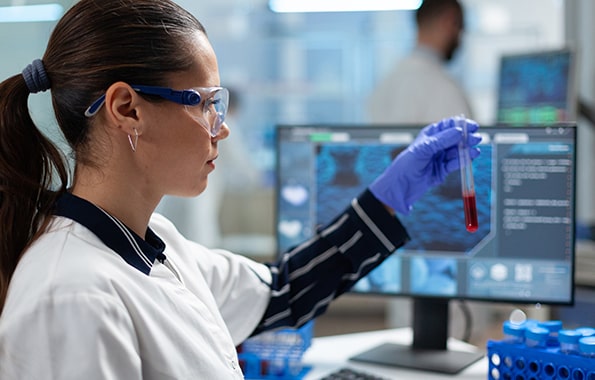
IVF services are designed with your journey in mind, recognizing the uniqueness of each individual and couple who walks through our doors. We understand that embarking on the path of assisted fertility is a significant decision, both emotionally and physically, and we’re here to support you every step of the way.
Our team of experienced fertility specialists is dedicated to providing personalized care tailored to your specific needs and circumstances. We believe in a holistic approach to IVF, focusing not only on the medical aspects but also on the emotional well-being of our patients.
You’ll be met with a compassionate and understanding environment when you step into our state-of-the-art facility. We aim to create a comfortable space where you can openly discuss your concerns, ask questions, and receive clear, transparent information about the IVF process.
We understand that fertility journeys can be challenging, and we’re committed to offering you the resources and support you need. Our counselling services are available to help you navigate the emotional aspects of the journey, providing a safe space to address any anxieties or fears you may have.
At care 24 IVF centre, cutting-edge technology and innovation merge with a human touch. We’re proud to offer the latest advancements in assisted reproductive techniques, giving you the best possible chance of success. But beyond science, we believe in fostering a sense of hope and optimism for all our patients.

In Vitro Fertilization (IVF) is a medical procedure used to help individuals and couples struggling with infertility conceive a child. There are several reasons why IVF services might be necessary or beneficial:
IVF offers hope to individuals and couples who wish to have children but face various fertility challenges. It has helped millions worldwide achieve their dreams of parenthood by providing an alternative path to conception. However, it’s important to note that IVF is a complex and often expensive procedure that may not suit everyone. Decisions about whether to pursue IVF should be made in consultation with medical professionals based on individual circumstances and medical advice.

Introduction:
In Vitro Fertilization (IVF) is a widely used assisted reproductive technology that helps individuals and couples struggling with infertility achieve pregnancy. The IVF procedure involves fertilizing an egg with sperm outside the body in a controlled laboratory environment. Here is a step-by-step guide to the IVF procedure:
Step 1: Ovulation Induction:
The initial stage of the IVF process entails prompting the ovaries to generate multiple eggs. This is achieved through hormonal medications, such as follicle-stimulating hormone (FSH), which encourages the growth and maturation of several egg-containing follicles.
Step 2: Monitoring and Follicle Growth:
Blood tests and ultrasounds closely monitor the patient’s progress during ovulation induction. These tests help the medical team track the growth of the follicles and the levels of hormones in the body.
Step 3: Egg Retrieval (Ovum Pick-Up):
Once the follicles have reached an appropriate size, a minor surgical procedure known as egg retrieval is performed. Under sedation or anaesthesia, a thin needle is guided through the vaginal wall and into the ovaries to retrieve the mature eggs from the follicles. This procedure is usually conducted using ultrasound guidance.
Step 4: Sperm Collection:
Concurrently with the egg retrieval procedure, a sperm specimen is obtained from the male partner or a designated sperm donor. Following collection, the sample undergoes processing and refinement to separate and select the most vigorous and viable sperm cells.
Step 5: Fertilization:
The gathered eggs and processed sperm are merged within a laboratory receptacle to initiate fertilization. The ensuing hours involve close monitoring of the eggs to detect indications of successful fertilization. Alternatively, in certain instances, a technique called intracytoplasmic sperm injection (ICSI) might be employed. This involves directly injecting a lone sperm into an egg, aiding the fertilization process.
Step 6: Embryo Culture:
After fertilization, the embryos are cultured in a controlled environment for a few days. During this time, we will be monitored for growth and development. The medical team selects the healthiest embryos for transfer into the uterus.
Step 7: Embryo Transfer:
A thin catheter carefully transfers The selected embryos into the woman’s uterus. This procedure is typically done without anaesthesia, similar to a Pap smear. The number of embryos transferred is usually decided based on factors such as the woman’s age and embryo quality to maximize the chances of successful pregnancy while minimizing the risk of multiple pregnancies.
Step 8: Luteal Phase Support:
After embryo transfer, hormonal medications such as progesterone support the uterine lining and increase the chances of successful implantation.
Step 9: Pregnancy Test:
Around 10 to 14 days after the embryo transfer, a blood test is performed to determine if pregnancy has occurred. A positive result indicates that implantation has occurred and the pregnancy has begun.
Step 10: Pregnancy Monitoring:
If the pregnancy test is positive, regular monitoring of the pregnancy’s progress is carried out through ultrasounds and hormone level assessments.
4517 Washington Ave, Manchester,
Kentucky .England 524163.
Phone : (480) 555-0103